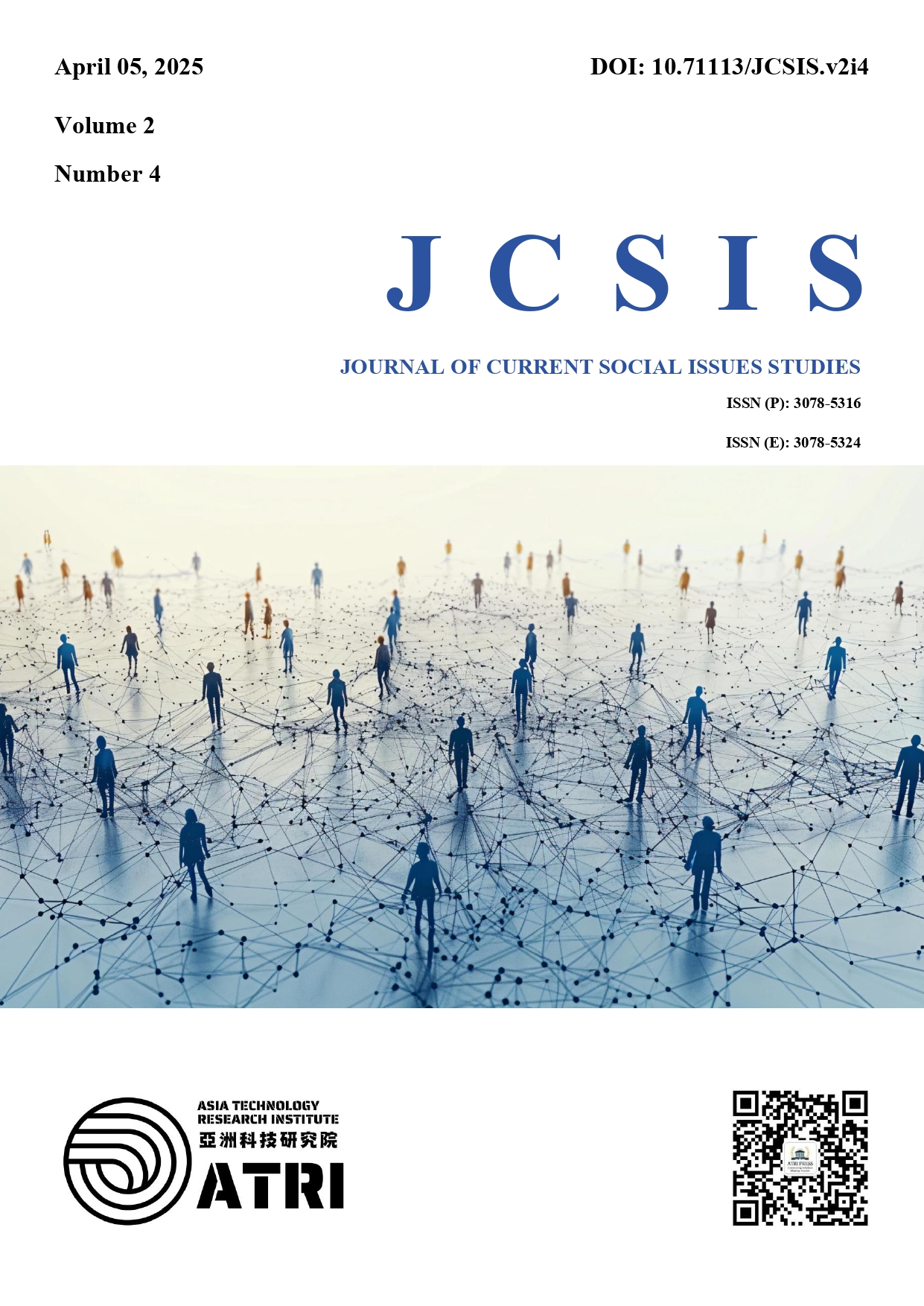Exploring the Triangular Relationship Among Corporate Social Responsibility (CSR), Carbon Emissions, and Corporate Value: An Empirical Investigation
DOI:
https://doi.org/10.71113/JCSIS.v2i4.216Keywords:
Corporate Social Responsibility; Carbon Emission Intensity; Firm Value; Mediating Effect; Listed CompaniesAbstract
In the context of carbon neutrality, enterprises in the European Union face challenges related to greenhouse gas emissions. With increasing attention on corporate social responsibility and the impact of carbon emission intensity on corporate value, this study selected 50 large EU listed companies as the research subjects and used panel data from 2009 to 2023. A multivariate regression model was employed to empirically test the mediating effect of carbon emission intensity between corporate social responsibility and internal corporate value.The research findings indicate that corporate social responsibility influences internal corporate value, and there indeed exists a mediating effect of carbon emission intensity between corporate social responsibility and internal corporate value, with a mediating effect value of 7.996%.
References
Agency, U. S. E. P. (2024). Greenhouse gas reporting program (GHGRP). U.S. Environmental Protection Agency. Retrieved April 23, 2024, from https://www.epa.gov/ghgreporting
Bai, S. X., & Zhang, J. X. (2019). The moderating effect of carbon information disclosure on carbon emissions and company value. Ecological Economy, 35, 26–31.
Barnea, A., & Rubin, A. (2010). Corporate social responsibility as a conflict between shareholders. Journal of Business Ethics, 97(1), 71–86.
Bitat, A. (2018). Environmental regulation and eco-innovation: The Porter hypothesis refined. Eurasian Business Review, 8(3), 299–321.
Brammer, S., & Millington, A. (2008). Does it pay to be different? An analysis of the relationship between corporate social and financial performance. Strategic Management Journal, 29(12), 1325–1343.
Canada, E. A. C. C. (2023). Reporting greenhouse gas emissions data: Technical guidance 2022 and 2023. Environment and Climate Change Canada. Retrieved April 23, 2024, from https://www.canada.ca/en/environment-climate-change/services/climate-change/greenhouse-gas-emissions/facility-reporting/reporting/technical-guidance-2022.html
Chapple, L., Clarkson, P., & Gold, D. (2011). The cost of carbon: Capital market effects of the proposed emission trading scheme (ETS). Abacus, 49(1), xx–xx.
Chen, X., Wang, Y., & Yang, Z. (2020). Corporate social responsibility and corporate value: The moderating role of organizational inertia and industry sensitivity. Technology Economics, 39(1), 140–146, 158.
Diamond, J. (2009, Month Day). Will big business save the Earth? International Herald Tribune.
Doran, J., & Ryan, G. (2012). Regulation and firm perception, eco-innovation, and firm performance. European Journal of Innovation Management, 15(4), 421–441.
Dou, X. (2015). The lag effect of corporate social responsibility on financial performance: An empirical analysis based on panel data of Shanghai and Shenzhen listed companies. Industrial Economic Review, 74–81.
Druckman, A., & Jackson, T. (2009). The carbon footprint of UK households 1990–2004: A socio-economically disaggregated, quasi-multi-regional input–output model. Ecological Economics, 68(8-9), 2066–2077.
Dunfee, T. W. (2006). A critical perspective of integrative social contracts theory: Recurring criticisms and next-generation research topics. Journal of Business Ethics, 68(3), 303–328.
He, Y., Li, J., Cai, M., & Zhang, X. (2020). Corporate social responsibility and corporate value: The mechanisms of marketing competitiveness and customer awareness. Journal of Management Engineering, 34(1), 84–94.
Hu, W. Y., & Zhang, X. H. (2020). The reverse forcing effect of corporate environmental social responsibility on green innovation. Finance and Accounting Newsletter, 58–62.
Huang, Y. X., & Yao, Z. (2016). Corporate social responsibility report, impression management, and corporate performance. Economic Management, 38(1), 105–115.
Johnson, H. H. (2003). Does it pay to be good? Social responsibility and financial performance. Business Horizons, 46(6), 34–40.
Johnston, D. M., Sefcik, S. E., & Soderstrom, N. S. (2008). The value relevance of greenhouse gas emissions allowances: An exploratory study in the related United States SO2 market. European Accounting Review, 17(4), 747–764.
Longendyke, N. S. A. L. (2015). A global look at mandatory greenhouse gas reporting programs. World Resources Institute. Retrieved April 23, 2024, from https://www.wri.org/insights/global-look-mandatory-greenhouse-gas-reporting-programs
Mackey, A., Mackey, T. B., & Barney, J. B. (2007). Corporate social responsibility and firm performance: Investor preferences and corporate strategies. Academy of Management Review, 32(3), 817–835.
Matsumura, E. M., Prakash, R., & Vera-Munoz, S. (2014). Firm-value effects of carbon emissions and carbon disclosure. The Accounting Review, 89(2), 695–724.
Sen, S., & Bhattacharya, C. B. (2001). Does doing good always lead to doing better? Consumer reactions to corporate social responsibility. Journal of Marketing Research, 38(2), 225–243.
Shahbaz, M., Ozturk, I., Afza, T., & Ali, A. (2013). Revisiting the environmental Kuznets curve in a global economy. Renewable & Sustainable Energy Reviews, 25, 494–502.
Shan, M., Lin, Y., & Cheng, F. (2019). A study on the nonlinear relationship between corporate social responsibility and financial performance. Friend of Accounting, 45–51.
Sitompul, M., Suroso, A. I., Sumarwan, U., & Zubainarni, N. (2023). Revisiting the impact of corporate carbon management strategies on corporate financial performance: A systematic literature review. Economies, 11(1), 171.
Sprinkle, G. B., & Maines, L. A. (2010). The benefits and costs of corporate social responsibility. Business Horizons, 53(5), 445–453.
Tu, H., & Zheng, H. (2018). Corporate social responsibility, ownership, and corporate value. Nankai Business Review (Philosophy and Social Sciences Edition), 147–156.
Wen, Z., Zhang, L., Hou, K.-T., & Liu, H. (2004). Testing and application of the mediating effects. Acta Psychologica Sinica, 36(5), 614–620.
Williamson, O. E. (1963). Managerial discretion and business behavior. American Economic Review, 53(5), 1032–1057.
Yang, L. (2012). Corporate value and corporate social responsibility. Economic Research Reference, 34(2), 34–35.
Yang, W. S., & Yang, S. L. (2016). An empirical study on the relationship between corporate social responsibility and financial performance in the Chinese context—A comparative analysis of large, medium, and small-sized listed companies. Chinese Management Science, 24(6), 143–153.
Yin, F., Xiao, Y., Cao, R., & Zhang, J. (2023). Impacts of ESG disclosure on corporate carbon performance: Empirical evidence from listed companies in heavy pollution industries. Sustainability, 15(12), 15296.
Downloads
Published
How to Cite
Issue
Section
License
Copyright (c) 2025 Shubin Yin

This work is licensed under a Creative Commons Attribution 4.0 International License.















